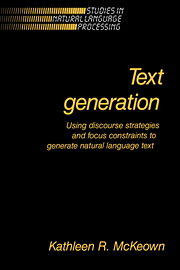Book contents
- Frontmatter
- Contents
- Preface
- 1 Introduction
- 2 Discourse Structure
- 3 Focusing in discourse
- 4 TEXT system implementation
- 5 Discourse history
- 6 Related generation research
- 7 Summary and conclusions
- Appendix A Sample output of the TEXT system
- Appendix B Introduction to Working
- Appendix C Resources used
- Appendix D Predicate Semantics
- Bibliography
- Index
6 - Related generation research
Published online by Cambridge University Press: 23 December 2009
- Frontmatter
- Contents
- Preface
- 1 Introduction
- 2 Discourse Structure
- 3 Focusing in discourse
- 4 TEXT system implementation
- 5 Discourse history
- 6 Related generation research
- 7 Summary and conclusions
- Appendix A Sample output of the TEXT system
- Appendix B Introduction to Working
- Appendix C Resources used
- Appendix D Predicate Semantics
- Bibliography
- Index
Summary
Interest in the generation of natural language is beginning to grow as more systems are developed which require the capability for sophisticated communication with their users. This chapter provides an overview of the development of research in natural language generation. Other areas of research, such as linguistic research on discourse structure, are also relevant to this work, but are overviewed in the pertinent chapters.
The earliest generation systems relied on the use of stored text and templates to communicate with the user. The use of stored text requires the system designer to enumerate all questions the system must be able to answer and write out the answers to these questions by hand so that they can be stored as a whole and retrieved when needed. Templates allow a little more flexibility. Templates are English phrases constructed by the designer with slots which can be instantiated with different words and phrases depending upon the context. Templates may be combined and instantiated in a variety of ways to produce different answers. One main problem with templates is that the juxtaposition of complete English phrases frequently results in awkward or illegal text. A considerable amount of time must be spent by the designer experimenting with different combinations to avoid this problem.
Both of these methods require a significant amount of hand-encoding, are limited to handling anticipated questions, and cannot be extended in any significant way. They are useful, however, for situations in which a very limited range of generation is required particularly because the system can be as eloquently spoken as the designer.
- Type
- Chapter
- Information
- Text Generation , pp. 185 - 194Publisher: Cambridge University PressPrint publication year: 1985



